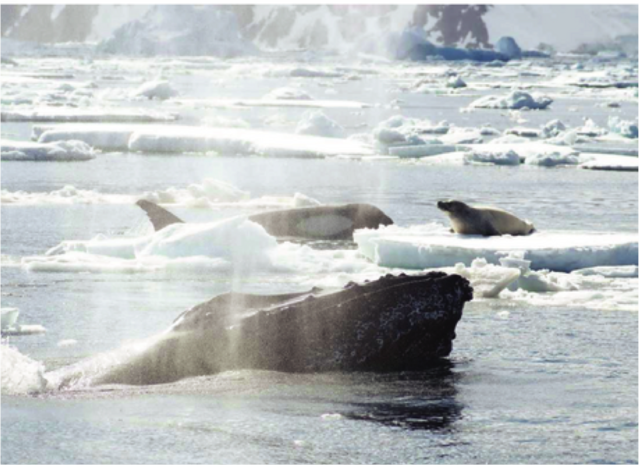Altruism
Animal Altruism?
New research describes how humpback whales protect seals from harm.
Posted October 18, 2016
By Kristin Brethel-Haurwitz and Abigail Marsh
In January of 2009, the marine ecologists Robert Pitman and John Durban were aboard a research vessel off the West Antarctic Peninsula when they encountered a strange and marvelous sight.
As they recently described in Marine Mammal Science, the researchers were observing a pod of eleven killer whales attacking a Weddell seal that had sought refuge on an ice floe. That wasn’t the strange part, though—seals are a mainstay of killer whales’ diets. The strange part was that, as Pitman and Durban watched, two massive humpback whales surged into the middle of the action.
This was no effort to be sociable. Killer whales are humpbacks’ natural enemies, and the two species do not normally intermingle. Nor were the humpbacks, who eat only tiny shrimp and fish, joining in the hunt.
No, by all appearances, the humpbacks were helping the seal.
The killer whales eventually succeeding in breaking up the seal’s ice floe, dumping it back into the water. The seal then swam straight toward the humpbacks. When it reached them, Pitman and Durban watched in astonishment as one of the humpbacks rolled over onto its back and swept the seal up onto its belly with a nudge of its flipper. There, the seal briefly rested in safety as though lying atop a slick, blubbery ice floe.
The presumably befuddled seal (Pitman and Durban described it as “freaked out”) soon swam off to find a more conventional resting place. But the ecologists, and we, are left to wonder why this strange episode happened in the first place. Was it altruism?

For biologists, altruism includes any behavior that benefits another individual at a cost or risk to the altruist. So biologically speaking, the whale’s behavior was altruistic. It sacrificed its own energy and safety and the only obvious beneficiary was the seal.
Why would one animal ever make sacrifices to help another?
Many acts of animal altruism can be explained via two established theories. Kin selection dictates that animals will preferentially help their relatives, thereby benefiting the altruist’s own genetic legacy. Kin selection can explain many acts of altruism among animals that live in groups. For example, prairie dogs are more likely to bark out risky warning calls to alert their relatives to seek shelter. But kin selection cannot explain why a whale would help a member of a different species. Neither can the other major biological theory of altruism, reciprocity, which dictates that help will be given to those who have helped in the past, or who may in the future. But a seal can’t possibly help a whale in return for its protection.
But an explanation is clearly needed. What the humpback whales did was no fluke—it was one of over 70 recorded episodes of humpbacks intervening in killer whale attacks on unrelated species. And humpbacks are not the only species known to help other animals. There are many stories of dolphins rescuing humans, dogs, and each other from sharks and fishing nets, and documented episodes of apes helping injured animals and even human children who fall into their enclosures.
Is it possible that acts of interspecies altruism like these can result from genuine psychological altruism—the motivation to improve another’s welfare?
It was once believed that psychological altruism required a level of cognitive complexity that only humans possess. It’s true that no other species can match humans’ ability to think abstractly, reason, or use grammatical language. But none of these abilities appear to be necessary for altruism.
Felix Warneken and his colleagues have demonstrated that children as young as 18 months old will provide help to adults in need. And several research groups have demonstrated that a range of animal species, from bonobos to the humble rat, will act altruistically to help others. In one study, laboratory rats, worked to free trapped, distressed cagemates from restrainers, even if it meant giving up chocolate for themselves.
This suggests that altruistic motivation springs not from high-level concerns about justice and morality—which are the purview of humans—but from lower level emotional processes that humans share with many other animals, from rats to whales. Activity in emotional brain structures like the amygdala, insula, and striatum, support empathy, which is the ability to understand when others are in need or distress, and caring, which is the desire to alleviate that state. These processes may suffice to motivate altruism in humans and non-humans alike. Our own research has linked variations in the size and activity of the amygdala to empathic sensitivity and extraordinary acts of human altruism, like donating a kidney to a stranger. The amygdala has also been linked to prosocial behavior in bonobos and rats.
Because non-human animals cannot talk, it is impossible to know for certain what motivates their behavior. Did the humpbacks who rescued the Weddell seal understand that it was in distress, and genuinely desire to help it? Once upon a time, this interpretation would have been considered hopeless anthropomorphism—the projection of humanlike qualities onto animals. But the primatologist Frans de Waal argues that “anthropodenial", the denial that humans and animals share many abilities and traits, is an equally serious mistake.
When a humpback whale swims into a pod of attacking killer whales and rescues a seal, it is reasonable to consider a variety of possible causes for this behavior.
But what is not reasonable is to deny that altruism is one of them.
Written with assistance from Katie O'Connell, B.S.




